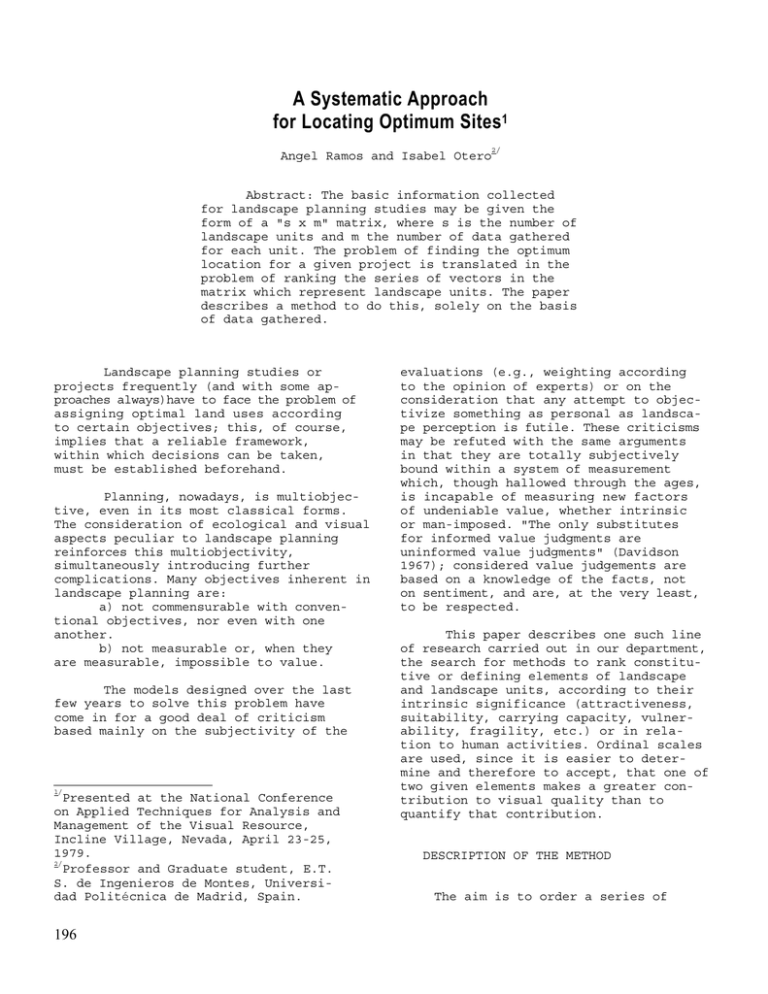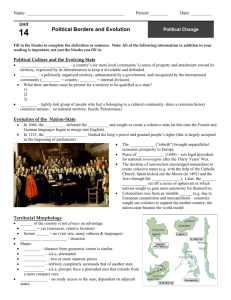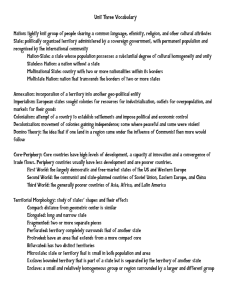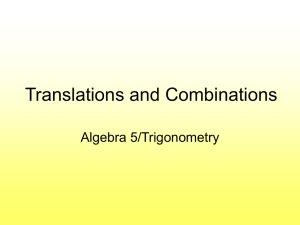A Systematic Approach for Locating Optimum Sites
advertisement

A Systematic Approach
for Locating Optimum Sites1
2/
Angel Ramos and Isabel Otero
Abstract: The basic information collected
for landscape planning studies may be given the
form of a "s x m" matrix, where s is the number of
landscape units and m the number of data gathered
for each unit. The problem of finding the optimum
location for a given project is translated in the
problem of ranking the series of vectors in the
matrix which represent landscape units. The paper
describes a method to do this, solely on the basis
of data gathered.
Landscape planning studies or
projects frequently (and with some approaches always)have to face the problem of
assigning optimal land uses according
to certain objectives; this, of course,
implies that a reliable framework,
within which decisions can be taken,
must be established beforehand.
Planning, nowadays, is multiobjective, even in its most classical forms.
The consideration of ecological and visual
aspects peculiar to landscape planning
reinforces this multiobjectivity,
simultaneously introducing further
complications. Many objectives inherent in
landscape planning are:
a) not commensurable with conventional objectives, nor even with one
another.
b) not measurable or, when they
are measurable, impossible to value.
The models designed over the last
few years to solve this problem have
come in for a good deal of criticism
based mainly on the subjectivity of the
l/
Presented at the National Conference
on Applied Techniques for Analysis and
Management of the Visual Resource,
Incline Village, Nevada, April 23-25,
1979.
2/
Professor and Graduate student, E.T.
S. de Ingenieros de Montes, Universidad Politécnica de Madrid, Spain.
196
evaluations (e.g., weighting according
to the opinion of experts) or on the
consideration that any attempt to objectivize something as personal as landscape perception is futile. These criticisms
may be refuted with the same arguments
in that they are totally subjectively
bound within a system of measurement
which, though hallowed through the ages,
is incapable of measuring new factors
of undeniable value, whether intrinsic
or man-imposed. "The only substitutes
for informed value judgments are
uninformed value judgments" (Davidson
1967); considered value judgements are
based on a knowledge of the facts, not
on sentiment, and are, at the very least,
to be respected.
This paper describes one such line
of research carried out in our department,
the search for methods to rank constitutive or defining elements of landscape
and landscape units, according to their
intrinsic significance (attractiveness,
suitability, carrying capacity, vulnerability, fragility, etc.) or in relation to human activities. Ordinal scales
are used, since it is easier to determine and therefore to accept, that one of
two given elements makes a greater contribution to visual quality than to
quantify that contribution.
DESCRIPTION OF THE METHOD
The aim is to order a series of
vectors, representing points in the
territory, whose coordinates are expressed in non-commensurable terms. The
basic idea is to establish and make
explicit ordinal relationships with
adjustments according to certain criteria or factors conditioning the definition of the problem.
The observations relating to the
ecological and landscape variables
characterizing the environment usually
refer to points on a network or particular territorial units; they may thus
be expressed in a matrix:
s = N° of points or territorial
units
m = N° of elements defining the
landscape
This information, gathered in the
preliminary phases of the study, is
merely descriptive, nominal and has no
direct significance for planning; it
must, therefore be made operative. One
procedure consists in establishing an
ordinal relationship, once each variable
j (j=1, 2, ---, m) has been defined and
the different jk types presented by
each have been characterized, between
the partial descriptions and the values
1, 2, ----, nj on an ordinal scale,
where nj is t1e number of values on the
ordinal3scale with which the element j
types have been related.
For instance, let us suppose that
the visual vulnerability of landforms
is to be considered and that this variable has been divided into three types.
The relation, in this case, could be
established as follows:
Nominal description
Ordinal scale
1 (Highest)
pjl = steep slopes
2
pj2 = gentle slopes
3 (Lowest)
pj3 - plain grounds
The matrix ((P)) describing the
territory is thus expressed as follows:
i = 1, 2, ----, s
nij ε 1, 2, ----, nj
Definitions
Given two points in the territory:
A = (n1, n2, ---, n m ) and
B = (n 1′, n 2′, ---, n m′)
we say that A precedes or is superior
to B (A < B) if, and only if, ni ≤ n i′,
vi = 1, 2, ---, m.
Thus, A = (1,2,4,4) precedes to
B= (2,2,5,6) since 1<2, 2=2, 4<5, 4<6.
If ni<n i′ is not held for every i, as
in A = (1,2,4,4) and C = (2,1,3,6), we
say there are non-inferior points to
each other.
Process
These definitions lead to a first
obvious ordination, not sufficient
however in most cases because the relation will only work for a few points.
But the process may continue by calculating the number of points each precedes
and is preceded by, and a new order may
be established between the columns of
the matrix, i.e., between the points in
the territory.
A more general view is obtained
if, instead of starting from the matrix
((nij)), whose dimensions are s x m,
another is considered which contains all
theoretically possible cases, its dimenm
sions being, therefore, n x m for a
territory described by m elements each
divided into n types. The real case may
thus be considered a sub-set of the complete set of all possible cases and this
sub-set may in turn be compared with
the case considered in isolation.
Let a point A=(n 1 , n 2 , ---, n j ,--, nm) in the theoretical general matrix containing the data: njε1,2,---,n.
If we consider only the first column of A, each point whose first element is lower than or equal to n1, precedes A. By analogy, all points whose j
column is occupied by values lesser
than or equal to n. will precede A. Consequently, if equality is included among
the precedences, the total number of
compositions preceding A will be given
by:
j= m
N1=n1xn2x --- x nj x --- nm = π nj
j=1
197
Similarly, the points preceded
by A will be all those whose j column
is occupied by values higher than or
equal to n., V.. If, in this case, equality is also included in the precedences,
the number of compositions preceded by A
will be
j= m
N2=(n+1-n1) (n+1-n2)--(n+1-nm)= π (n+1-nj)
j= 1
So, by calculating N1 and N2, a
set of vectors with m coordinates
(n 1 ,n 2 , ---, nm ) is exchanged for another
set of vectors with two coordinates (N1,
N2), which are easier to order.
Now, a point A = (N1, N2) will be
superior to or will precede another_
point, B = (Ni, N2) if, and only if,
{
N1 < N1′
or
{
N1 < N1′
N2 > N2′
If the relation existing between
A and B is:
N2 > N2′
{
N1 > N1′
or
{
Figure 1--Initial tree, for m=3, n=4. Only the
different combinations are used.
N1 < N1′
N2 > N2′
N2 < N2′
we shall say that A and B are non-inferior to each other.
Coming back to the example of
points A = (1,2,4,4) and C = (2,1,3,6),
in which we now put n=6:
N2A 6x5x3x3=270
N1A lx2x4x4=32
N2C=5x6x4xl=120
N1C=2xlx3x6=36
N1A <N
, N2A> N2C, A < C
1C
Therefore, points A and C, initially non-inferior, become ordinated in the
first calculation of precedences: A precedes to C.
The simple structure of the general theoretical matrix, makes it possible
to construct a "tree" to reflect an initial order of points (fig. 1). By calculating the precedences, the set of vectors
with two coordinates (N1, N2) is obtained.
These coordinates may also be arranged on
a "tree" with a more clearly defined
structure, again allowing the number of
points preceding and preceded by each to
be counted (fig.2). Thus, by repeating the
process, the existing non-inferiori-ties
will be resolved until the total order is
obtained, at which point no further counts
will be necessary (fig. 3).
198
Figure 2--Tree of precedences, first iteration.
Calculations are made on the number of variations.
-Repeat the process with the new values
(N3, N4).
-Make successive repeats until no further ordering is possible.
-Tabulate the final order, indicating
the combinations corresponding to each
level.
Comments
The algorithm is based on the
formation of combinations rather than
variations; thus, for example, the point
(1,1,2,2,) is not differentiated from
the point (1,2,1,2). This is only possible if each element considered descriptive of the landscape is divided into an
equal number of classes, since, in this
case, all the variations derived from
the same combination will have the same
(N1, N2) values and will consequently be
situated on the same level.
Figure 3-- Tree of precedences, second iteration. Final result.
GENERAL ALGORITHM
Given m and n:
-Make ( n + m 1 ) possible combinations of
n
(n1, n2, ---, nm)
- Calculate for each:
j= m
N1 = π nj
j= 1
j= m
N2 = π (n+1-nj)
j= 1
- Establish order relationships
A=(N1, N2) < B=( N1′
, N2′)
if, and only if,
{
N1 > N1′ or
N2 < N2′
{
N1 > N1′
N2 < N2′
A=(N1, N2) > B=(Nj, N2)
if, and only if,
{
N1 > N1′ or
N2 < N2′
{
N1 > N1′
N2 < N2′
- Calculate, for each point, the number
of combinations preceding it, N3, and the
number preceded by it, N4.
Calculations are made on the total
number of variations, although only the
distinct combinations are used. When the
number of descriptive elements -m- is
high, this simplification becomes necessary, as the number of possible variations is several orders of magnitude
greater than the number of combinations
and the excessive volume of data would
render the system inoperative. Thus, for
example, in a fairly common case, 10
descriptive elements divided into 6 classes (m=10, n=6) might be considered;
the number of possible combinations would
be (10 + 6 1 ) = (15) = 3003 , and the number of
10
10
7
variations somewhat over 6xl0 .
When nl≠n2≠....≠nm (nj is the number of classes into which each element j
is divided), the values of N1 and N2
will be:
j= m
N1 = π hj
j= 1
j= m
(hj+1-hj)
N2 = π
j= 1
for a point (hl, h2, ---, hm)
Once these values have been deduced
the process continues exactly as is the
case where n1=n2=...=nm.
If the points are ordered taking
all possible combinations into account,
classifications from two different territories may be compared, since the
199
levels will have the same meaning in
both. There will, however, be no equivalence between levels of two trees
based on real data.
If a project has to be made for a
given territory, it may be more practical to consider real units for, in this
case, the order will more faithfully
reflect the characteristics of the area,
in that the best points will appear at
the first level, even though they may
not be of excellent quality.
Nevertheless, the structure of the
territory under study may be better
understood if the real data are situated in a more general framework. More--
200
over, if only slight differentiation is
required, all points being grouped in
a small number of classes, it may be
advisable to deduce the classification
from the total number of possible combinations and, subsequently, place the
combinations occurring in reality at
the appropriate level.
LITERATURE CITED
Davidson, P.
1967. Cited in The natural resources
decision-maker as political and
economic man: toward a synthesis.
R.M. Alston and D.M. Freeman. J.
Environ. Manag. 3(3):167-183





